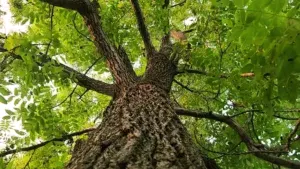Post Oak Wood
- September 6, 2023
- 0 comment

Post Oak is a North American hardwood tree characterized by its robust growth and unique branching structure. With a stout trunk and the potential for substantial growth, Post Oak trees stand as notable features of the landscape. The wood derived from Post Oak trees finds utility in various applications owing to its inherent durability and innate resistance to decay, making it a valuable resource with enduring practical value.
Texture
Post Oak wood displays a distinct coarse and uneven texture, often accompanied by a straight grain that may interlock at times. This textural composition significantly bolsters the wood’s strength, rendering it versatile for a range of applications that benefit from its sturdy nature.

Bark
The bark of Post Oak trees evolves into a grayish-brown facade, characterized by a scaly and ridged texture as the tree matures. This textured bark not only adds to the visual allure of the tree but also serves as a tactile testament to its growth over time.

Furniture
Renowned for its robustness, Post Oak wood finds its place in furniture-making, particularly for crafting enduring pieces. Its inherent strength and density position it favorably for constructing resilient chairs, tables, and various furniture items designed to withstand frequent use.

Weapon
Steeped in historical significance, Post Oak wood was once employed by Native American tribes to forge tools and weapons, benefiting from its innate toughness and durability. Although less prevalent in modern weaponry, its historical relevance continues to resonate.

Firewood
Post Oak wood emerges as prized firewood, recognized for its dense composition and deliberate, slow-burning attributes. It produces substantial heat and minimal ash, earning its reputation as a reliable source of warmth during colder seasons.

Construction
The history of utilizing Post Oak wood in construction underscores its indispensability for crafting items that demand strength and stability. Its application spans load-bearing elements like beams and posts, contributing to the structural integrity of buildings.

Plywood
While not a prevalent choice for plywood due to its coarse texture and limited availability, Post Oak wood’s inherent strength and density render it a potential candidate for specialized plywood applications requiring exceptional quality.

Board
Available in the form of boards, Post Oak wood extends its utility to diverse woodworking projects. Its robust character lends itself adeptly to tasks such as cabinetry, fine furniture crafting, and various woodworking endeavors.

Pallet
The durability and strength inherent in Post Oak wood position it optimally for fashioning resilient pallets, capable of enduring the rigors of heavy loads and rugged handling.

Fencing
Post Oak wood stands as a reliable choice for crafting fencing solutions that harmoniously balance aesthetic appeal with structural robustness. Its natural resistance to decay further extends its longevity in outdoor enclosures.

Live Edge Siding
Post Oak wood finds an artistic expression in live edge siding, introducing an organic, rustic dimension to architectural designs. The irregular edges offer a distinct portrayal of the tree’s character, enhancing the visual narrative.
Beams
Renowned for its strength and durability, Post Oak wood thrives in the role of beams, whether in structural or decorative applications. Its historical preference as a choice for beams underscores its time-honored reliability in construction projects.
Frequently Asked Questions
- What is Post Oak wood commonly used for?
Post Oak wood is frequently used for furniture making, construction, and outdoor applications due to its durability and strength. - How does Post Oak wood compare to other oak species?
Post Oak wood shares similar traits with other oak species, such as strength and durability. However, its coarse texture and unique appearance distinguish it from other oaks. - Is Post Oak wood suitable for indoor furniture?
Yes, Post Oak wood is a suitable choice for crafting indoor furniture pieces like tables, chairs, and cabinets due to its sturdiness and ability to withstand regular use. - Can Post Oak wood be used for making weapons like historically?
While Post Oak wood was historically used for crafting tools and weapons by Native American tribes, it is less commonly employed for such purposes in modern times due to the availability of more specialized materials. - What makes Post Oak wood a good option for firewood?
Post Oak wood’s density and slow-burning characteristics make it ideal for firewood. It provides consistent heat and produces minimal ash, making it a reliable source of warmth. - Is Post Oak wood suitable for building structures?
Yes, Post Oak wood has a history of use in construction, particularly for load-bearing components like beams and posts. Its strength and durability contribute to the structural integrity of buildings. - Is Post Oak wood used in woodworking projects other than furniture?
Absolutely, Post Oak wood is available in board form and can be used for various woodworking projects, including cabinetry, fine woodworking, and decorative items. - Can Post Oak wood be found as plywood?
While not commonly used in plywood production due to its coarse texture and limited availability, Post Oak wood’s strength and density could make it suitable for specialized plywood applications. - Has Post Oak wood been used for railroad cross ties?
In the past, Post Oak wood was occasionally used for railroad ties due to its durability. However, its use has decreased over time due to the emergence of more suitable alternatives. - Is Post Oak wood used for crafting pallets?
Yes, the durability and strength of Post Oak wood make it well-suited for crafting sturdy pallets capable of enduring heavy loads and rough handling. - Is Post Oak wood suitable for outdoor fencing?
Yes, Post Oak wood can be employed for crafting durable and visually appealing fencing solutions, benefiting from its natural resistance to decay and robust composition. - Can Post Oak wood be considered for wood decking?
Due to its inherent strength and resistance to wear, Post Oak wood can be a viable option for wood decking, providing longevity and durability to outdoor decks. - What is the significance of Post Oak wood in architectural applications?
Post Oak wood can be used for live edge siding, adding a rustic and distinctive touch to architectural designs. Its irregular edges highlight the tree’s natural character, enhancing visual appeal. - How is Post Oak wood used in beams for construction?
Renowned for its strength and durability, Post Oak wood is frequently employed in both structural and decorative beams, contributing to the stability and aesthetics of construction projects.
As we conclude this exploration, the enduring tale of Post Oak wood unfolds—a testament to nature’s tenacity and the artistry of craftsmanship. With its robust texture, history-steeped strength, and diverse applications, Post Oak wood invites us to connect with tradition and innovation. From the foundations of historic structures to the intricacies of finely crafted furniture, Post Oak wood is a conduit that bridges the past and present. As you embark on your woodworking endeavors, may the resilience and character of Post Oak wood infuse your creations with a touch of timeless elegance, reminding us that within every grain lies a story waiting to be shaped anew.














Leave your comment